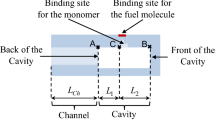A new mathematical model of Reversible Addition-Fragmentation chain Transfer (RAFT) polymerization is proposed, describing a series of experimental data on styrene bulk polymerization in the presence of various RAFT agents. The polymerization slowdown observed with increasing concentration of the RAFT agent is attributable to the accumulation of intermediate products that participate in chain transfers to both low-molecular and polymer RAFT agents, whereas the length of the initiation period is determined entirely by the activity of the low-molecular RAFT agent.
Similar content being viewed by others
References
W. A. Braunecker and K. Matyjaszewski, “Controlled/living radical polymerization: Features, developments, and perspectives,” Progress in Polymer Science, 32, 93–146 (2007).
S. I. Kuchanov, M. Yu. Zaremsky, A. V. Olenin, E. S. Garina, and V. B. Golubev, “Kinetics of radical polymerization with participation of iniferters,” Dokl. Akad. Nauk SSSR, 309, 371–375 (1989).
M. Yu. Zaremski, S. M. Mel’nikov, A. V. Olenin, S. I. Kuchanov, E. S. Garina, M. B. Lachinov, V. B. Golubev, and V. A. Kabanov, “On the absence of the gel-effect in free-radical polymerization with participation of iniferters,” Vysokomol. Soedin., Ser. B, 32, 404–405 (1990).
S. I. Kuchanov and A. V. Olenin, “Application of iniferters for synthesis of compositionally homogeneous copolymers,” Vysokomol. Soedin., Ser. B, 33, 563–564 (1991).
M. Yu. Zaremski, A. V. Olenin, E. S. Garina, S. I. Kuchanov, V. B. Golubev, and V. A. Kabanov, “Mechanism of photoinitiated polymerization of styrene in the presence of iniferter of benzyl dithiocarbamate,” Vysokomol. Soedin., Ser. A, 33, 2167–2175 (1991).
S. I. Kuchanov and A. V. Olenin, “Application of iniferters for obtaining composition homogeneous copolymers,” Polym. Bull., 28, 449–450 (1992).
S. I. Kuchanov, “Quantitative theory of radical copolymerization with participation of iniferters,” Vysokomol. Soedin., Ser. A, 35, 87–94 (1993).
S. I. Kuchanov, “Quantitative theory of iniferter polymerization. I. Kinetics,” J. Polymer Sci., 32, 1557–1588 (1994).
J. Chiefari, Y. K. Chong, F. Ercole, J. Kristina, J. Jeffery, T. P. T. Le, R. T. A. Mayadunne, G. F. Meijs, C. L. Moad, G. Moad, E. Rizzardo, and S. H. Thang, “Living free-radical polymerization by reversible addition-fragmentation chain transfer: the RAFT process,” Macromolecules, 31, 5559–5562 (1998).
T. P. Le, G. Moad, E. Rizzardo, and S. H. Thang, PCT Int. Pat. Appl. WO 98/01478, 1998, Chem. Abstr., 128, 115390 (1998).
D. Charmot, P. Corpart, D. Michelet, S. Zard, and T. Biadatti (Rhodia Chemie), PCT Patent WO 9858974, 1998; Chem. Abstr., 130, 82018 (1999).
M. Benaglia, J. Chiefari, Y. K. Chong, G. Moad, E. Rizzardo, and S. H. Thang, “Universal (switchable) RAFT agents,” J. Amer. Chem. Soc., 131, 6914–6915 (2009).
D. J. Keddie, G. Moad, E. Rizzardo, and S. H. Thang, “RAFT agent design and synthesis,” Macromolecules, 45, 5321–5342 (2012).
C. Barner-Kowollik (ed.), Handbook of RAFT Polymerization, WILEY-VCH, Weinheim (2008).
C. Barner-Kowollik, J. F. Quinn, T. L. Uyen Nguyen, J. P. A. Heuts, and T. P. Davis, “Kinetic investigations of reversible addition fragmentation chain transfer polymerizations: cumyl phenyldithioacetate mediated homopolymerizations of styrene and methyl methacrylate,” Macromolecules, 34, 7849–7857 (2001).
M. J. Monteiro and H. Brouwer, “Intermediate radical termination as the mechanism for retardation in reversible addition−fragmentation chain transfer polymerization,” Macromolecules, 34, 349–352 (2001).
S. I. Kuchanov and T. V. Zharnikov, “Scattering properties of gradient heteropolymers obtained by ‘living’ free-radical copolymerization,” Europ. Phys. J. Ser. E, 7, 183–202 (2002).
T. V. Zharnikov, A. S. Yakovlev, and S. I. Kuchanov, “Quantitative theory of ‘living’ free-radical polymerization. III. Calculation of copolymerization products’ spinodal,” J. Polym. Sci., Pt B, 41, 892–902 (2003).
T. V. Zharnikov, Thermodynamic Description of Synthetic Gradient Copolymers [in Russian], Candidate dissertation, Moscow State University, Faculty of Physics (2003).
A. R. Wang and S. Zhu, “Effects of diffusion-controlled radical reactions on RAFT polymerization,” Macromolecular Theory and Simulations, 12, 196–208 (2003).
A. D. Peklak, A. Butte, G. Storti, and M. Morbidelli, “Gel effect in the bulk reversible addition-fragmentation chain transfer polymerization of methyl methacrylate: modeling and experiments,” J. Polymer Sci. Pt A, 44, 1071–1085 (2006).
N. V. Ulitin, T. R. Deberdeev, and A. A. Berlin, “Controlling the molecular weight and polydispersity index of polystyrene by varying the initial parameters of addition–fragmentation radical polymerization,” Rus. J. Phys. Chem. B, 8; 227–232 (2014).
S. W. Prescott, “Chain-length dependence in living/controlled free-radical polymerizations: physical manifestation and Monte Carlo simulation of reversible transfer agents,” Macromolecules, 36, 9608–9621 (2003).
E. V. Chernikova, A. V. Tarasenko, E. S. Garina, and V. B. Golubev, “Controlled radical polymerization of styrene mediated by dithiobenzoates as reversible addition-fragmentation chain-transfer agents,” Polymer Science, Ser. A, 48, 1046–1057 (2006).
E. V. Chernikova, P. S. Terpugova, E. S. Garina, and V. B. Golubev, “Controlled radical polymerization of styrene and n-butyl acrylate mediated by trithiocarbonates,” Polymer Science, Ser. A, 49, 108–119 (2007).
E. V. Chernikova, Pseudo-Living Radical Homo- and Co-Polymerization by Reversible Chain Transfer Mechanism [in Russian], doctoral dissertation, Moscow State University, Faculty of Chemistry (2010).
Author information
Authors and Affiliations
Corresponding author
Additional information
Translated from Prikladnaya Matematika i Informatika, No. 47, 2014, pp. 60–76.
Rights and permissions
About this article
Cite this article
Semendyaeva, N.L., Kuchanov, S.I. Mathematical Modeling of Raft Polymerization. Comput Math Model 26, 514–527 (2015). https://doi.org/10.1007/s10598-015-9288-8
Published:
Issue Date:
DOI: https://doi.org/10.1007/s10598-015-9288-8




